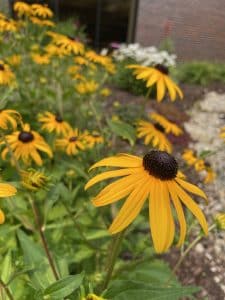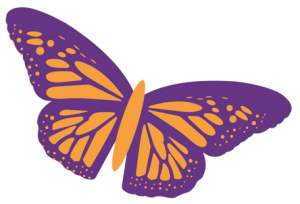March 14 is National Learn About Butterflies Day. Like bees, bats and other insects, butterflies are nature's pollinators. Plants and flowers need pollination to help produce fruit or seeds. Pollinators, like butterflies, visit flowering plants in search of food or nectar and pick up and distribute pollen along the way.
Butterflies serve a vital purpose in sustaining a healthy ecosystem and environment. Did you know butterflies and other pollinators help pollinate over 80% of the world's flowering plants? That becomes the food we eat. However, the pollinator population has been in an alarmingly steady decline. Habitat loss, climate change, disease, pesticides and invasive plants all threaten the survival of butterflies and other pollinators.

Did you know?
- Butterfly wings are transparent.
- There are almost 20,000 butterfly species.
- Butterflies use their feet to taste.
- The lifespan of butterflies is up to six weeks.
- The most common butterfly in the U.S. is the Cabbage White. It is called that because of its green and white markings like the vegetable.
- Some butterfly species migrate from cold climates. They fly south for the winter where it is warmer and sunnier.
- Butterflies drink nectar using their proboscis, which acts like a straw.
- Butterfly wings display a colorful spectrum that is used as a defense mechanism to help protect them against predators.
- The largest butterfly is the Giant Swallowtail. Its wingspan measures between 4 and 7 inches.
How can you help butterfly conservation?
- Plant a wildflower garden to provide a habitat for pollinators and "Bee Counted". To learn more about pollinator gardens or to register your butterfly garden, visit the Million Pollinator Garden Challenge.
- Use natural and organic pesticides and keep your garden healthy and less harmful to your family and the pollinators. For a list of DIY products, take a look at these 8 Natural and Homemade Insecticides to Save Your Garden Without Killing the Earth.
- Support pollinator-friendly businesses in our local area.
- Help distribute milkweed seeds to your family, friends and school.
- Visit a butterfly habitat.
Butterfly Habitat and Sanctuaries
Barson’s Greenhouse, Brenda’s Butterfly Habitat, Westland
Brenda Dziedzic, who has lectured all over the country about butterflies, opened the habitat in 2012. The habitat is home to dozens of nectar plants, especially milkweed. You’ll see lots of butterflies in the summer months. There’s a koi pond to visit too.
Butterfly Garden at the Detroit Zoo, Royal Oak
Experience over 25 species of butterflies engaging in a natural habitat built just for them. Kept at a balmy 75 degrees Fahrenheit, it is the perfect temperature for butterfly-watching.
People for Palmer’s Park Butterfly Garden, Detroit
This butterfly garden was created in 2016 for families to learn about and enjoy the beauty of butterflies in an urban setting. Michigan native flowering plants were chosen to benefit butterfly conservation.
Pollinator Habitat at Heritage Park, Canton
Canton Township is pleased to announce the addition of pollinator gardens in Heritage Park and Ridge Road Park. “Butterflies and bees need plenty of native, flowering plants to thrive,” said Abe Vinitski, Canton Parks Supervisor. “By increasing the amount of dedicated habitat for these pollinating insects, we hope to add nesting sites that are critical to their survival, as well as serve as inspiration to others to add pollinator habitats in their yards.”
Butterfly Books for Kids
Marion's Got the Butterflies – Marion volunteers at the Santa Vista Arboretum butterfly release and helps her younger sister Gabby overcome her fear of bugs so she can also attend the event.
The Story of a Butterfly – A study on this popular butterfly encourages children toward curiosity and exploration and ends with a call to make the earth more accessible for everyone from humans to the tiniest bug.
Monarch Butterflies – Rich, detailed information about the monarch's life cycle, anatomy, and the wonders of their signature migration.
Monarch Butterfly – Describes the life cycle, body parts, and behavior of the monarch butterfly, and includes instructions on how to raise a monarch.
My Book of Butterflies – A stunning exploration of butterflies from around the world, and a beautiful book for budding young naturalists.
Butterfly Books for Adults
Handmade Houses and Feeders for Birds, Bees, and Butterflies – Provides instructions for building birdhouses and feeders, discussing the tools and materials to use, woodworking techniques, and bird safety.
Native Plant Gardening for Birds, Bees, & Butterflies – This guide introduces 109 native plants that readers can utilize to benefit birds, bees and butterflies in the Upper Midwest.
Planting for Butterflies – Presents information on how to attract butterflies and help them flourish by creating a butterfly-friendly garden.
Attracting Birds and Butterflies – Creating a garden that welcomes these creatures may seem like a confusing and complicated task, but it’s relatively simple. Essentially, wildlife needs food, water and shelter, just like we do, and this illustrated guide shows which plants attract which creatures, and how to plant and care for them.




Add a comment to: Flutter By, Butterfly